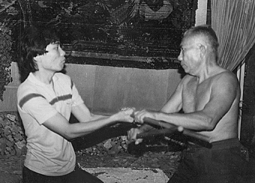|
|
The basic core of Balintawak training, is a reactive ‘counter to counter’ style and is taught virtually and is more effectively learnt ‘one on one’. The student is taught defensive and offensive techniques, where at all times there needs to be a coach to guide the student through their moves from the very basic to the advanced. A level in the latter parts of the students training will be reached where the student and instructor ‘give and take’ all the techniques of the style.
Initially, for the beginner, Balintawak can seem to be a very defensive style. When the instructor attacks, the student will learn to defend with a block and counter with a ‘single’ strike. This is where other styles argue that their systems are better as they learn to counter with multiple strikes. Balintawak is different. Balintawak considers that an opponent will defend effectively your counter strike and counter your counter. A lot of Escrima schools do not consider that an opponent will defend themself properly to a counter. But what if they do? Of course if the opponent does not defend properly then they leave themself open to multiple strikes. Balintawak however, pays due consideration that an opponent may be skilled and that every move has a counter and that every counter has a counter. It is simply timing that plays the major role between skilled Escrimadors.
|
|
A simple outline of instruction of the Balintawak style as taught in the VMA : The student is taught twelve basic strikes, then taught basic blocks and counters to these strikes. The instructor will then attack in the ‘12 basic strikes’ and the student will block and counter this series. Later, as the students timing, control, speed and footwork combine properly, the instructor will then attack with ‘At Random’ strikes and then later will introduce stronger and faster random attacks which are sometimes called ‘Pak Gung’. The 12 Basic Strikes, At Random and Pak Gung are only the beginning. They are the basic foundation or platform of Balintawak and can be a very enjoyable free style, free flowing, free wheeling form of play. |
 Atty. Jose Villasin and Bianor Villasin C 1979 |
An advanced set series of attacks are now used by the instructor against the student and the student will learn the advanced set series of counters and defence to the instructor’s attacks. These set series are called the ‘Grouping’ or ‘Groups’ method, and are considered a type of grading system. They answer questions such as "What do you do if your counter has been grabbed, what is the defence?" One of the groups will show the student how to defend in this situation. "What if the opponent tries to disarm or grabs and locks your stick or arm and punches?" The Groups answer these questions and the style is gradually built up, further and further by showing the counters to the counters, from the basic platform of the style. When the student does all the techniques from the groups in a flowing fashion, then the movements between the student and instructor will become an advanced freewheeling motion, all based on the students and instructors individual timing.
To some people that may sound like the end of the learning but it’s not. You will always be learning, both as a student and instructor, as each student and instructor of Balintawak are different human beings and each can have variations in their timing, as well as in their fighting.
Balintawak has no single person Katas or patterns, nor does it have hard rigid long stances but uses short, very mobile stepping movements just as if the person was walking. The student is taught to be elastic in their actions and can use an evading, twisting long style sometimes referred to as ‘bamboo’ or 'Kawayan'. They can use the more forceful ‘breaking’ or ‘sikit’ style where the emphasis is upon the distance of the empty hand to be able to touch the opponent’s shoulder, or they can use the low, tight, bobbing and weaving styled movements sometimes called 'Likay' or 'Lahay'.
Balintawak for safety teaches the use of a single stick for the majority of their training, but it is emphasised that each strike can be either a slash, butt or thrust like a bladed weapon. Balintawak teaches the ‘principles’ behind the movements of the stick work, so that variations of these moves can be used to defend yourself without thinking "Do I have a knife, sword or am I unarmed". Balintawak does teach some specific stick, knife, sword and empty hand techniques but the majority of the principles are the same and if you understand the principles you can apply the variations.
A good Balintawak instructor can teach you to understand the similarities in weapons principles and in so doing, understand the variations in their uses and apply them.
It is not what the student learns that sets Balintawak apart from other styles of Escrima. There are no secrets to Balintawak. Most styles are basically the same and have movements common to each other. It is the 'method of teaching' that Balintawak has, that sets it apart from other styles and it will be shown to you that it is "more than just stickfighting".
Velez Balintawak Twelve Basic strikes; #1 left temple, #2 right temple, #3 right ribs or elbow, #4 left ribs or elbow, #5 stomach thrust, #6 right chest thrust, #7 left chest thrust, #8 left knee, #9 right knee, #10 right face thrust, #11 left face thrust, #12 head and solar plexus.
Back to the Balintawak index page
| Home | seminars | balintawak | doce pares | tat kun tao | VMA instructors | travel pics | articles | FMA instructors | downloads | email | links |
©1998-2003 John Russell

